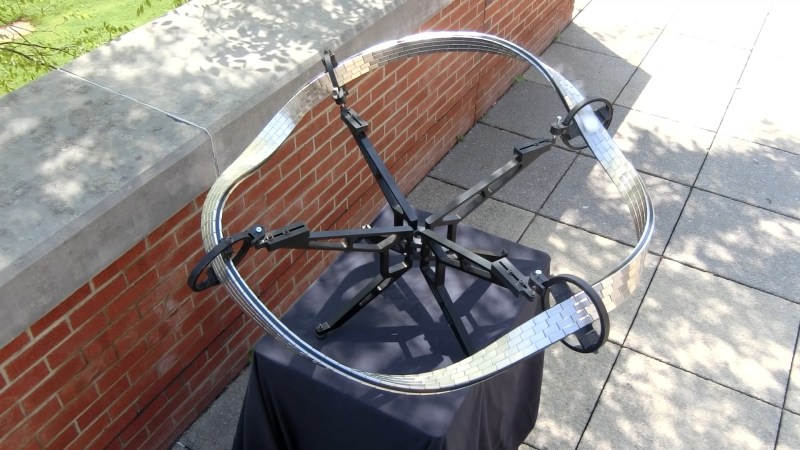Superconductors are interesting things, though we don’t really rely on them for much in our day to day lives. They’d be supremely useful, if only they didn’t need to be so darned cold. While the boffins toil away in the lab on that problem however, there’s still some fun to be had, as demonstrated by the Möbius Strip levitation track at Ithaca College. (Video, embedded below.)
The rig takes advantage of the fact that superconductors can levitate over magnets, and vice versa. Under certain conditions, the superconductor can even lock into position over a magnet, due to flux pinning, wherein flux “tubes” from the magnet’s field penetrate a superconductor and are pinned in place by currents in the superconductor. It’s an awe-inpsiring effect, with the superconducting material appearing to magically float at a locked height above the magnetic surface, quite distinct from traditional magnetic levitation.
Construction of the track wasn’t straightforward. Early attempts at producing a Möbius Strip twisted through 540 degrees were unsuccessful in steel. The team then switched tack, using a flexible plastic which was much more pliable. This was then covered in neodymium magnets to create the necessary field, and the resulting visual effect is one of a silver-bricked magnetic road.
It’s a great display, and one that quite intuitively demonstrates the concepts of both a Möbius Strip and superconducting levitation. If room-temperature semiconductors become a real thing, there’s every possibility this could become an always-on installation. It’s also the trick behind one of the coolest hoverboards we’ve ever seen. Video after the break.
















“The rig takes advantage of the fact that superconductors can levitate over magnets, and vice versa. This is due to flux pinning”
This isn’t quite right. Superconductors levitate over magnets due to the Meissner effect – magnetic fields can’t penetrate a superconductor, so they bend to avoid it, producing the force to levitate them. For a type-I superconductor, the Meissner effect is perfect as long as it’s a superconductor.
What they’re showing, however, isn’t just levitation, it’s flux pinning, like you’re saying. And *that* needs a type-II superconductor (…basically), where the field gets locked in place by a superconducting vortex. Type I superconductors would just slide off the track. Type II superconductors lock to the magnets.
So to be clear, you don’t need flux pinning for levitation, you need it to stick to the track like they’re showing.
You opened the pedantism door. You can get flux pinning in type-I too.
I said “basically”!
Backpedal.
Hey, if someone manages to do an example like this with a type-I superconductor, I’d *love* to see it. Of course, working with a sub-micron thickness object cooled by liquid helium against much stronger magnets might be a bit of a challenge. You’d get more kudos from me, though!
Which is why I said, basically, you need a type-II superconductor for this.
It’s not a backpedal if he qualified the comment with “basically” on that note, so long as the larger point still stands. It’s perfectly reasonable to oversimplify a complex explanation with qualification so the audience is aware there’s more to it.
Only if it’s a really thin superconductor right?
Unfortunately, mech/aero engineering degrees haven’t started to include superconductor courses just yet.
Yup. It’s easiest to understand in terms of the Ginzburg-Landau parameter, which split superconductors into type-I/type-II (OK, OK, it’s the phase transition order which does, but c’mon). It’s a ratio of the penetration depth (how quickly the field falls off inside the superconductor) to the coherence length (basically the scale on which superconducting behavior can change). Small Ginzburg-Landau parameter means type I, larger means type II.
But if you make the thickness very small, in some sense it’s the *thickness* that starts to matter in that ratio, not the coherence length (cuz, beyond that distance… no more superconductor), and so you can push the behavior to be more like type II.
That parameter’s related to the energy cost of forming a superconducting boundary: for type-I superconductors, it *costs energy* to form a normal/superconducting boundary. For type-II, it’s energetically favorable to form boundaries. So essentially by making the superconductor thin, you’re making it favorable to form non-superconducting spots in the superconductor where the field cuts through.
Damn, I’ve been dreaming of this! I maintain a Mobius strip exhibit in a museum that has a little motorized cart that runs around it. The gearbox and electrical contacts are more trouble than it ought to be, and I often think about how cool maglev would be instead…
If you read my science fiction novel: “TIME TRIP ON A MOEBIUS STRIP,” you will discover what happens when you ride a giant metal Moebius Strip inside a vehicle…..within a giant nautilus shell that rests over a magnetic field.
https://www.youtube.com/watch?v=6ANSuD2y2KM
Cool..
Is there a rock or mineral that is very attracted to a magnet, and not a conductor of electricity?
… Could a meteorite be attracted to a magnet and have no resistance?
Magnetite.